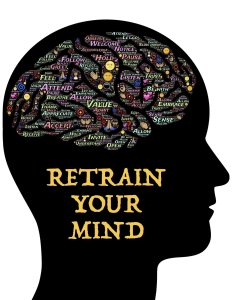The Enneagram personality system of the 9 types or what I alternatively call 9 “Ego Identities“, can be an immensely powerful source of personal growth and self-development. Unfortunately, most people are unable to utilize the wisdom of the Enneagram to create tangible, true growth and move up the health levels.
Most people, even those who discover their true Enneagram type(s), fall prey to the ego identities’ dark side or downfall: being overly self-identified with the narrow worldview, coping mechanisms, and survival strategy each Enneagram type is predisposed towards.
Having an Enneagram type is typically treated as a badge of (dis)honor, rather than a starting point from which you can start shifting your worldview and improving your quality of life. Those of us who have never had to stumble down the abyss tend to be more freed from the constraints of their ego identity. But those who need to improve their mindset the most, tend to have been broken down by the terror of their ego identities’ warped reality, and tend to reside stuck down there.
Based on my own journey and observation of others who have climbed out of the pit towards the light, including those who don’t even know about the Enneagram, I believe I have discovered the hidden key(s) behind Enneagram / ego growth. The long-lost answer to my own question:
How do we actually advance and move up the health levels?

The answer to that question lies in understanding and utilizing the two keys below, in order to open your own door towards your self-actualization and personal fulfillment.
Key 1: Mental Freedom of the Ego Identity

Roughly, this first part is widely acknowledged and discussed by most Enneagram enthusiasts: being and becoming aware of your Enneagram type and its constraints and bad habits, usually called “sins”.
Surely, awareness and acknowledgement can be a first step in identifying your demons. If you are left in the dark, you won’t be able to see and identify them, and then not able to find the best strategy to eliminate them.
If you still struggle with identifying your type, book a Get•Typed session with me.
However, most people stop right there. They know their demons, they know their struggles. But as it is typical of their ego identity, they accept their demons as the truth or eternal condition. That way, their demons will always keep a hold of them.
Most people feel resignation towards their personal demons and Enneagram type or worldview. They think “This is just how it is, nothing else to do than to live with it”. This is not entirely untrue – we do have an inescapable ego identity that guides our behavior. But that does not mean we have to remain a victim to our own minds – we always have the option to be(come) our own heroes.
Our awareness and mental fortitude enables us to take control and move beyond the constraints that our ego identity may present or cling unto, whenever it “believes” this is the best way of survival – even if it is misguided.
If you are mentally unhealthy, you’ll surely know that the methods of your ego identity are not working for you right now. If they were, you would not be mentally unhealthy!
Once you have acknowledged and accepted the constraints and bad habits of your Enneagram type/Ego identity – a crucial step in being able to “see” the demons – the next and most important step is to question and undermine their reality and validity, thereby disempowering them.
The beauty of the Enneagram is its presentation of the primary 9 different ways how our human egos may see the world or handle a particular issue. They demonstrate a minimum of 9 versions of reality! On their own, none of those 9 realities are the only truth.
So whenever you encounter a particular problem and are inclined to react or think from the habitual pattern of your ego identity…
Stop and ask yourself:
- Is this really how it must always be?
- What is the other, more constructive spin I could put on this?
- How does another type of person see and handle this same issue in a good way?
- What’s the other side of reality I am ignoring right now?
- What would my life be like if I chose to believe or do the opposite of what I am normally inclined to?
This part actually requires mental training and can be quite uncomfortable in the beginning, like unused muscles that are screaming in pain.
However, you need to actively retrain your mind and person, so that you do not automatically believe your limiting beliefs and do not follow the bad habits, preprogrammed by your type. That is how you are able to gain mental freedom – otherwise you’ll remain subjugated to your own ego.
A common and popular example is of the Type 6’s journey from fear to bravery. Batman in The Dark Knight Rises (2012) is faced with the growing edge of 6 having to face their fears to truly grow. He needs to climb up a pit that is extremely challenging and possibly deadly if you fall. But as long as Batman uses a rope to keep him safe, he is not able to get higher – because that way, he doesn’t face and grow above his fears.

For the (counterphobic) Type 6, ignoring or denying their fear, to be “fearless”, does not truly make them grow deep down, because that way they still avoid the true fear. For the (phobic) Type 6, their anxiety makes them flee or freeze and not face their fears either.
The individual who is aware of this tendency can tell themselves that it is normal they’ll be scared in this situation. The average person will stop there. They will be scared and not do anything about it, either not acting on what they desire or on the other extreme, deny or “react” and lash out. They’ll keep living in this gruesome reality, tied to the rope, at the bottom of the pit.
But then you need to ask yourself: “What would my life be like if I actually acted the other way?” or “What would my life be like if I didn’t have this belief and lived as if it wasn’t reality?”
Whenever you are plunged into your own pit, you need to question its reality. It’s quite possible the pit does not even exist outside of your own mind!! So why live your life as if it was real?
Batman left the rope and faced his fear of falling in order to rise above his ego, so that he could save Gotham.
You need to live your life according to the reality and behaviour that is most suitable to what you need.
Because whenever you follow the bad habits that your ego identity is inclined to do, you will live the average to unhealthy life of that type.
This is how you’ll gradually attain mental freedom and self-sovereignty: Instead of succumbing to your bad habits and limiting beliefs, you refuse to believe them and instead act in favor of what is necessary for you to feel fulfilled.
Your ego identity will remain with all its demons, but you’ll finally be (more) in control of those demons, so that your life opens up to you.
Key 2: Fulfill the Needs of your Instincts

This is the most crucial and most underestimated key, if not the Holy Grail, to improving your entire life: Fulfilling the needs of your instincts! Based on the 3 instincts (Social, Sexual, Self-preservation).
As I said before, once you have mentally freed yourself from the constraints of your ego, the next and most important step is to meet your (instinctual) needs in the most beneficial manner.
You might wonder what your true and most essential needs are. They boil down to your first and second instinct in your instinctual stacking.
The instincts, which I also call “drives” because they drive all our desires deep down, need to be fulfilled to feel contentment and to improve our Enneagram health levels.
Especially the first and then the second instinct need to be fulfilled in positive ways. At the ideal peak of yourself, all instincts are fulfilled.
But do not assume you can rush to the third instinct first: Always put an emphasis on the first and second instinct and then third, otherwise you’ll keep struggling with personal happiness.
In my experience, meeting the needs of the instincts was the only and most direct way to climb up the health levels.
No matter how much someone studied their Enneagram type or read other self-help books, as long as they didn’t actively improve the quality of their instinctual life and met the needs of their instincts, they remained unchanged, idling at the bottom of the pit, wondering why nothing is getting better.
Here are the basic requirements for each instinct:
Social (So): belonging to a fulfilling social group or society, contributing value to it and receiving appreciation from it; having fulfilling social bonds and attachments, such as friendship(s)
Sexual (Sx): pursuing and expressing a personal passion (project); creating something new and valuable; having a fulfilling romantic or emotionally intimate relationship and attachment
Self-preservation (Sp): being physically fit and without serious ailments; financial security and adequate housing; good food and material necessities/affordances
Example: Batman self-actualized once he improved his physical condition after being beaten up by Bane (catalyst Sp) to fulfill his mission of saving his city/society (So). In the end, he also dated Catwoman (Sx).

Now you might wonder: How do I improve those instincts?
Each Enneagram type possesses their own unique gifts once they have freed themselves from the limiting monsters. Ironically, those demons can transform into angels. Read the best qualities and virtues of each Enneagram type to gain some inspiration.
For example, positive qualities of 6 are their devotion, loyalty – and later, bravery. For example, Batman was brave, loyal and devoted to his social cause of saving Gotham from mayhem.
Besides the Enneagram, I believe that all our individual skills and talents, as well as our Jungian type (MBTI / Socionics), give us the tools to fulfill our instincts in the manner we will do best.
Called TVT, I am currently working on descriptions of the 16 Types that showcase each type’s best matches and their unique “purpose role” (see their titles), which will be their path towards fulfilling their instincts and improving their lives. More on that in future posts!
If you want more guidance, you can book me.
Let me know what you think and good luck on your journey! 🙂

Thank you very much for your clarity over this topic, I’ve only discovered Enneagram and MBTI over the last few months, and came across your blog while looking for information about connections between types within the two systems.
I especially appreciate your descriptions of the three instincts in this post, as this is the part of Enneagram theory where I have run into a spot of confusion. I was able to find my core type quite easily, and the wings, tritypes, levels of health and triads were simple enough to follow also, but there seems to be a fair bit of contradictary information out there about instincts, especially in relation to the 27 subtypes. Stacking seems to make more sense and creates a more nuanced picture than an individual subtype could, so thank you again for helping to clear this up for me.
LikeLiked by 1 person
Awesome, I am glad to hear that! I used to struggle with the instincts the most too, ironically. Like you said, understanding the stackings makes it much easier. Because if you are of a certain enneagram type, you’ll be able to relate to all the “subtypes”, simply because that’s your enneagram type and you’ll go into each instinct, depending on circumstance etc etc.
Read more here:
https://typevolution.com/2016/08/28/the-most-common-instinctual-stackings-for-each-mbti-type/
https://typevolution.com/2016/09/05/enneagram-main-type-mbti-correlations/
LikeLike